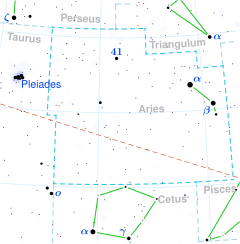| Observation data Epoch J2000 Equinox J2000 | |
|---|---|
| Constellation | Aries |
| Right ascension | 02h 18m 07.53022s[1] |
| Declination | +19° 54′ 04.1717″[1] |
| Apparent magnitude (V) | 5.58[2] |
| Characteristics | |
| Spectral type | A1 Vn[3] |
| U−B color index | +0.02[4] |
| B−V color index | +0.01[4] |
| Variable type | Constant[5] |
| Astrometry | |
| Radial velocity (Rv) | +6.0[2] km/s |
| Proper motion (μ) | RA: −7.491[1] mas/yr Dec.: −3.978[1] mas/yr |
| Parallax (π) | 7.6084 ± 0.1763 mas[1] |
| Distance | 429 ± 10 ly (131 ± 3 pc) |
| Absolute magnitude (MV) | −0.10[6] |
| Details | |
| A | |
| Mass | 2.10+0.37 −0.31 M☉[7] 2.94±0.06[8] M☉ |
| Radius | 1.9–2.5[9] R☉ |
| Luminosity | 106[6] L☉ |
| Surface gravity (log g) | 4.00±0.25[7] cgs |
| Temperature | 9,500±1,000[7] K |
| Rotational velocity (v sin i) | 186[10] km/s |
| Age | 107+286 −93[7] Myr |
| B | |
| Mass | 1.0+0.02 −0.04[7] M☉ |
| Temperature | 5,578±109[7] K |
| Metallicity [Fe/H] | 0.0[7] dex |
| Rotational velocity (v sin i) | 5[7] km/s |
| Other designations | |
| Database references | |
| SIMBAD | data |
Theta Arietis, Latinised from θ Arietis, is the Bayer designation for a binary star[7] system in the northern constellation of Aries. It is faintly visible to the naked eye with an apparent visual magnitude of 5.58.[2] With an annual parallax shift of 7.61 mas,[1] the distance to this star is an estimated 429 light-years (132 parsecs) with a 10-light-year margin of error. It is drifting further away with a radial velocity of +6 km/s.[2]
The primary, component A, is a white-hued, A-type main-sequence star with a stellar classification of A1 Vn.[3] It is spinning at a rapid pace as shown by the projected rotational velocity of 186 km/s.[10] This is causing the "nebulous" appearance of the absorption lines indicated by the 'n' suffix in the classification. In 2005, C. Neiner and associates classified this as a Be star because is displays emission features in the hydrogen Balmer lines.[5]
In 2016, a solar-mass companion was reported in close orbit around this star, based on observations using adaptive optics with the Gemini North Telescope.[7]
- ^ a b c d e f Cite error: The named reference
GaiaDR2was invoked but never defined (see the help page). - ^ a b c d Cite error: The named reference
scfswas invoked but never defined (see the help page). - ^ a b Cite error: The named reference
aj74_375was invoked but never defined (see the help page). - ^ a b Cite error: The named reference
aa19_229was invoked but never defined (see the help page). - ^ a b Cite error: The named reference
Neiner_et_al_2005was invoked but never defined (see the help page). - ^ a b Cite error: The named reference
Anderson2012was invoked but never defined (see the help page). - ^ a b c d e f g h i j Cite error: The named reference
Gullikson_et_al_2016was invoked but never defined (see the help page). - ^ Cite error: The named reference
Zorec_Royer_2012was invoked but never defined (see the help page). - ^ Cite error: The named reference
aaa367_521was invoked but never defined (see the help page). - ^ a b Cite error: The named reference
aaa463_2_671was invoked but never defined (see the help page). - ^ Cite error: The named reference
SIMBADwas invoked but never defined (see the help page).
